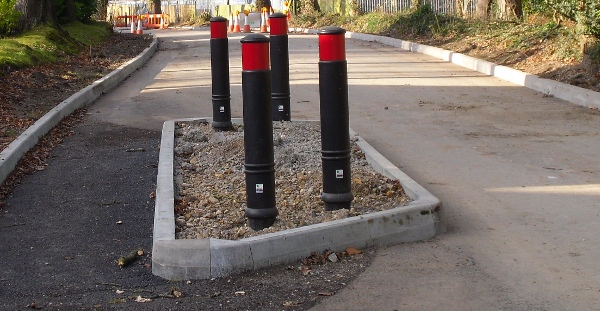Community News
The
Newsletter of the Community Campaign (Hart)
Issue 12, Spring 2012
Strategic Planning
There has been much press coverage about the controversy which
has resulted from a move by a number of land owners around
Winchfield to offer their land for consideration as sites for
housing in Hart’s Local Development Framework (LDF). When
adopted the LDF will be a binding document which is supposed to
specify the strategic development sites in Hart for the next 20
years.
The LDF is itself controversial and despite an overwhelming
negative response from public consultation, it still seeks to
build an additional 700 new homes on the green fields north of
Crookham Village. However grim this seems, it appears likely
that the situation will get worse as the government’s new
National Planning Policy Framework (NPPF) looks set to
substantially increase the number of new homes that will have to
be built in Hart over the next 20 years.
It seems unlikely that the main political parties on Hart
Council will be able to go against the new housing targets being
imposed by their government. However, you might think that a
fundamental shift in housing numbers should lead to a major
reassessment of the 20 year housing strategy. After all the
whole point about the LDF taking a 20 year view, is so that a
strategic approach to planning can be taken, to ensure that the
necessary infrastructure is also delivered.
Alas, there is no sign of common sense at work within the ruling
group at Hart. Instead, they want to compress the 20 year plan
into a 10 year plan and build houses at double the previous
projected rate. Then after 10 years, they no doubt intend to
come up with another short term 10 year plan.
A 10 year plan is not just cowardice (putting off having to
consider the unthinkable) but it also throws away the
opportunity to think strategically. This leads to the sort of
ill-thought out planning that has left Fleet & Church
Crookham with congested roads and Crookham Village suffering as
a rat run.
Imagine you need to build some 8,000 new houses in the next 20
years (as may be required by the NPPF). You could at one extreme
have a 1 year plan and re-think it each year. You would need to
plan for 400 homes each and every year but at this level you
would not have the critical mass to allow you to build a new
community with decent road access and new schools. Therefore the
only option open to you is to tag them onto the edge of the
existing urban area. The next year you are in the same position
and so you end up growing ever outwards with ever more
inadequate infrastructure and no overall strategy.
The Conservative group at Hart want a shorter term 10 year plan
because most of them live out in the countryside and would
appear to want to see the towns carry the full brunt of the
housing pressure. A 10 year LDF will see further expansion at
Edenbrook and more housing pushed on to Grove Farm. A follow on
10 year plan would still not have enough housing to justify a
new settlement, so the next 4,000 houses may well have to go to
the south of Crookham Village.
Crookham Village would lose its rural identity while Fleet &
Church Crookham would become choked off by a ring of concrete
that would slowly encircle it. Meanwhile no one benefits from
any significant new infrastructure.
It is totally abhorrent that a Government which promised
‘localism’ would railroad through legislation that could force a
predominantly rural area, such as Hart, to take far more housing
than it is capable of absorbing without having to build on
greenfield sites. However, this is what looks set to happen with
the emerging National Planning Policy Framework (NPPF) and is
certainly what Hart’s planning policy team are currently
promoting as the most likely scenario. It is an inescapable fact
that any substantial building programme in Hart will mean
building on greenfield sites somewhere.
If we are forced into such a situation, then local people must
expect their representatives not to bury their heads in the
sand. If our elected national government is going to foist
excessive levels of growth upon us, then Hart needs to look at
all the options, as unthinkable and unpalatable as they seem. We
need to give ourselves the opportunity to look at all the
options, even if they are limited and stark. We either continue
to grow Fleet & Church Crookham outwards (in which case
what, realistically, what do you do with the traffic?) or we
look at a new settlement.
Winchfield is about the only sustainable location for such a new
settlement in Hart District. It has a mainline railway station
and has the potential for either a new motorway access or better
access to the A30. A new settlement could be built with adequate
primary school provision and would, most importantly, have the
critical mass to justify a new secondary school with the other
nearby rural communities.
 Winchfield has its own mainline railway station
Winchfield has its own mainline railway station
I do not want to pre-judge which of these bleak options are best
– neither are very attractive or appealing. However, I do
believe that Hart needs to bite the bullet and at least do the
necessary work to analyse which option would be the least
detrimental for the most people. However, suggesting such an
approach seems to be heresy. The previous Conservative portfolio
holder for planning was sacked because he dared to try to
investigate the Winchfield option for himself. The story as
reported in the press was biased in that it focused on the
horror of the new Winchfield eco-village, yet did not point out
that the alternative is to extend Fleet & Church Crookham
ever outwards through Crookham Village.
We have to be open and honest and do a balanced review. Which
green fields are more important from a biodiversity standpoint?
By how much can you afford to expand Calthorpe Park School
before education standards start to slide? Which development
location will have the least adverse impact on traffic?
In May 2012, there will be another round of Hart District
elections. Local residents should demand that all candidates
standing for election should state where they stand on this
critical issue. Do they support the notion that when faced with
an unprecedented number of new houses, the only fair way to
address this abhorrent prospect is to research all the options?
Or do they believe we should just blindly carry on with the same
old plan of incremental development that has failed us for the
past 30 years?
No one wants to see yet more development but when the government
forces it upon us then we, as a community, do need to face the
challenge by thinking strategically and not just sleep-walk into
repeating the same old mistakes without at least evaluating the
alternatives.
QEB Update
Taylor Wimpey have been encouraged by Hart’s planning department
to bring forward an application to build an additional 100
houses on the QEB site. These houses would be built on the site
of the employment units which are in the original proposal.
Given that the need for employment on the QEB site was
identified in two public inquiries, it would appear to be a
mistake for Hart to be recommending the move from employment to
housing.
Planners are keen to emphasise the importance of ‘sustainable’
development but appear to view this as simply putting more
housing alongside what already exists. This is based on the
mistaken belief that where houses have already been deemed to be
sustainable, then additional houses on the same development must
also be sustainable.
Surely a sustainable development is one which caters for the
needs of the people who will live there? This must mean
including some form of opportunity for local employment, at
least that was the opinion of two different planning inspectors.
Planners often seem somewhat insulated from the hard economic
reality of life. Generally, buying a house requires you to have
a job to pay off your mortgage and having a job usually means
having a place to work.
With mass production now more economical in the Far East, a
manufacturing led economic recovery in the UK is going to be
reliant on small specialist companies. Equally, despite large
modern office blocks lying empty as victims of ‘off-shoring’,
successful smaller organisations still need somewhere to base
their operations.
So, it would seem to be prudent to build small light industrial
and small office buildings to complement housing developments.
Without these, we are giving in to the notion that everyone
either works from home, sits in a long traffic jam, or stands on
a crowded train to commute to work.
Replacing an area dedicated to providing local employment with
100 additional houses is rather short sighted and doesn’t seem
to fit in with what most people would consider ‘planning’ to be
about.
QEB traffic calming consultations
As the QEB development progresses, it is expected that a number
of traffic calming measures will be needed in order to manage
the impact of all the extra traffic. Unfortunately Hampshire
Highways seem to be convinced that the only effective traffic
calming measure is build outs (often known as chicanes). They
seem to have forgotten how dangerous and detested the chicanes
where on Elvetham Road when they were first built in response to
the Elvetham Heath development.
Chicanes don’t work as a traffic calming measure because too
many people speed up to get around them before any car
approaching the other way. They are also dangerous because they
force cars to drive head-on towards each other (how can that be
safe?) and, as was proved on Elvetham Road, people who don’t
expect them to be there promptly drive into them.
Speed bumps are generally detested because they are seen to
damage vehicle suspension or impede vehicles with a lowered
chassis. However, speed tables, such as those used at the road
junctions along Fleet Road do seem to work. Unlike chicanes,
everyone has to slow down for them but because the entire car
goes up onto them before coming down the other side, they are
not as damaging as speed bumps.
Despite much opposition from Quetta Park residents, Hampshire
Highways insist that chicanes are the best option. They base
this on the fact that although chicanes were criticized when
proposed for some local roads, no one said they shouldn’t be put
on roads around Quetta Park.
This is probably because, at the time, Highways did not draw
attention to the fact that chicanes were proposed on Naishes
Lane or Leipzig Road. Therefore, because no one objected on
these specific roads, the Highways ‘Engineers’ seem to feel
justified in putting them in!!
The moral of this story is if Hampshire consults in your area
about traffic calming (or other highways works) for your local
roads, then beware. If there are things you don’t think would
work, then you should state this in writing, even if such
measures don’t appear in the initial proposal.
A consultation on traffic calming for the roads closest to the
site is expected imminently. Further consultations may happen in
the coming year as more measures further afield come to be
required.

Build outs on Leipzig Road
but are they safe?
Crondall Report
by John Bennison

On 17th January the Boundary Commission released their final
decision document which set out how Hart should be re-divided up
into District wards. Their decision has followed an extensive
review, which has looked carefully at how to divide the district
up so that each ward has as near equal number of voters as
possible. Hart currently has 18 wards and 35 councillors. In May
2014 this will reduce to 11 wards, each with 3 elected
representatives. Clearly this has resulted in an extensive
redrawing of ward boundaries. One of the most affected areas in
the whole of Hart will be Crondall ward, which will be split in
two and lose its name.
Crondall itself will become part of a larger rural ward centred
around Odiham. Crookham Village and Ewshot (along with the QEB
site) will join with the western part of Church Crookham and
Zebon Copse to form a new ward.
Another local ward to disappear in 2014 will be the Fleet
Courtmoor ward, the north western part of which, will form part
of a new Fleet Central ward. The south eastern part of Fleet
Courtmoor will join with Church Crookham East.
The decision to have three Councillors in each ward was
predicated by Hart having district elections in three out of the
four years in the local election cycle. This is the main reason
why we have ended up with significantly larger wards than
before. With elections for the County in the fourth year of the
election cycle then everyone in Hart will have the opportunity
to vote in local elections every year.
New School for the QEB
In our last Newsletter we reported on our concerns that the
Local Education Authority (Hampshire County Council) were
prepared to turn down the opportunity to build a new school on
the QEB site. Since then the head teachers and school governors
of Tweseldown Infants & Church Crookham Juniors along with
members of Church Crookham parish council and Jenny Radley (as
the local County Councillor) have been busy lobbying hard to
persuade the LEA to think again.
All this hard work has paid off and Hampshire have changed their
minds, deciding to adopt the excellent suggestion first put
forward by the schools themselves. The plan now is to build a
new infant school on the QEB site, which the existing Tweseldown
Infant school will move into. This will leave space on the
Tweseldown Road site for Church Crookham Juniors to expand into
the vacated infant school. Hampshire will renovate the old
infant school building to make it suitable for use by junior
school children.
The new infant school is initially being built as a 3 form entry
facility. However, it will have the supporting infrastructure in
terms of the size of the communal areas (such as the school
hall) to be readily expanded to a 4 form entry school when
needed. The new infant school is scheduled to be completed for
occupancy in January 2014.
Published by: Julia Ambler,
39 Du Maurier Close, Church Crookham, Hampshire, GU52 0YA




